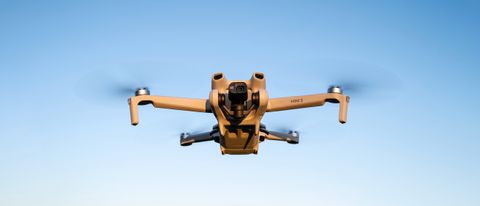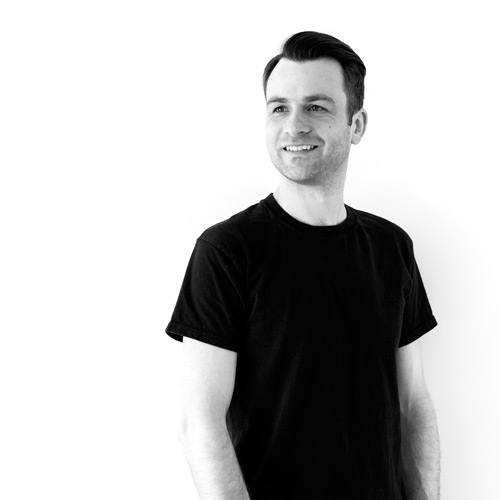Space Verdict
With identical image quality to the Mini 3 Pro, the DJI Mini 3 comes with a more beginner-friendly price at the cost of a handful of missing features.
Pros
- +
Sub 250g drone
- +
Excellent image quality
- +
Less expensive than the Mini 3 Pro
Cons
- -
No collision avoidance
- -
Reduced video functionality
- -
No subject tracking
Why you can trust Space.com
The beginner drone market is ever-expanding, and the release of the DJI Mini 3 (aka the DJI Mavic Mini 3) delivers a compelling option for beginners and those on a budget looking for a high-quality drone. And while it’s far from the least expensive beginner option available, image quality is head and shoulders above the competition.
Weight: 8.74oz / 248g
Dimensions: Folded 148×90×62mm / Unfolded 251×362×72mm
Battery:
Standard battery – 2453 mAh Li-ion / up to 38 minutes
Plus battery – 3850 mAh Li-ion / up to 51 minutes
Charger type: USB-C cable / AC Mains DJI 30W USB-C hub (available separately)
Modes: Cine, Normal, Sport
Video transmission range: up to 7.5 miles / 12km
Video resolution: 4K, 2.7K, 1080p (FHD)
Frame rates: 4K up to 30fps / 2.7K at up to 60fps / FHD at up to 60fps
The DJI Mini 3 uses the same camera as the higher-spec and indeed more expensive DJI Mini 3 Pro, so you can be confident that image quality is excellent for both photos and videos. The camera features a 1/1.3-inch 12MP sensor that can be rotated 90° to shoot in landscape and portrait orientations for capturing photos and videos.
Features are reasonable overall, with Quickshots automated flight patterns available for capturing professional-looking video with ease, but with the lower cost of the drone features are paired back when compared to the Mini 3 Pro. Collision avoidance is absent alongside 4K video at 60fps, the D-Cinelike color profile is unavailable, no 48MP photos, no Timelapse and no subject tracking.
Despite these shortcomings, it’s safe to say that the Mini 3 is one of the best beginner drones currently available. Plus, at just $559 | £519 for the standard kit with a DJI RC-N1 controller with two other kits available alongside a Fly More Bundle, it’s great value for beginners who would like to enjoy excellent image quality and DJI reliability on a budget.
DJI Mini 3 review: Design



- Small and lightweight folding design
- Longer battery life
- Two controller options
The DJI Mini 3 follows the classic Mavic series folding design to make the drone more compact for storage and transportation, and bears a striking resemblance to the Mini 3 Pro; the main difference is the lack of collision avoidance sensors on the Mini 3. In terms of size, there is a slight difference between the two models with the Mini 3 being 148×90×62mm folded and 251×362×72mm unfolded, but with a marginally reduced weight of 248g when a battery and microSD card are installed.
This means the drone is in the regulator-friendly sub 250g category, where in many regions restrictions are lower than with larger and heavier models; ideal for beginners and professionals alike. Perhaps due to the lower weight (by 1g), the Mini 3 offers longer advertised flight times than the Mini 3 Pro of up to 38 minutes compared to 34 minutes. During testing and taking the 25% battery charge when Return to Home is initiated, flight times were still on average a respectable 25 minutes.




Depending on your budget and needs there are two controller options available with the less expensive kit offering the DJI RC-N1 controller. This is the standard model where you attach a smartphone to a telescopic phone holder at the top of the controller to access drone and camera settings alongside viewing the camera feed.
The more expensive kit comes with the DJI RC Smart Controller featuring a 5.5-inch touchscreen with 700-NIT brightness. With the DJI RC, you have to connect the controller to your smartphone WiFi hotspot to be able to use maps, but it’s still more convenient overall. Firmware updates can be performed this way or using the DJI Assistant 2 app for Mac and Windows.
DJI Mini 3 review: Functionality
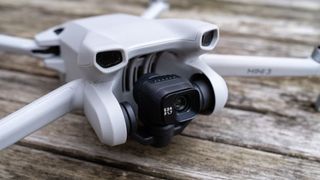
- GPS positioning
- Easy to set up and fly
- Quickshots
As a beginner model, the DJI Mini 3 is reassuringly easy to set up and fly so you won’t be overwhelmed by complexity when you first get started with flying drones. Geofencing is available by manually limiting flight altitude and distance, although the usual Beginner mode that limits both to 30m isn’t available. This is useful for absolute beginners, but once your flight experience and confidence grow you can increase altitude and distance within the legal amounts to begin capturing aerial photos and videos.
There are three main flight modes available with Cine being the slowest and providing reduced control sensitivity for capturing smoother video footage, Normal is the most commonly used mode with standard control sensitivity and a medium speed while Sport is the fastest with a top speed of 35.8mph. Wind resistance is up to 24mph, but with wind speeds over 20mph the drone can struggle in the air.
With the absence of collision avoidance, you have to take great care when flying close to obstacles such as trees but this shouldn’t be too much of an issue because you always have to maintain visual line of sight anyway. It’s undoubtedly a useful feature, but you can get by without it and the Mavic Mini and DJI Mini 2 didn’t offer this functionality so it’s not out of the ordinary for DJI’s most basic model.
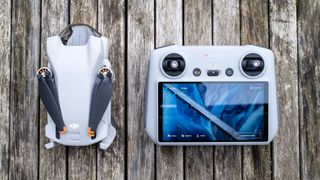
The drone does feature downward vision sensors to help with hovering accuracy and these work alongside GPS, Glonass and Galileo global satellite positioning. The main point of this is that the drone maintains its hovering position and doesn’t drift in the wind unless gusts are stronger than 24mph.
Other safety features include several Return to Home functions where the drone flies back autonomously to the take-off point. These include when the battery is low and when the connection between the controller and drone is weak or dropped. You can also initiate Return to Home at any time by pressing the button on the controller.
A feature that’s great for beginners is Quickshots, which has been included in the DJI Mini 3. These are automated flight patterns that allow you to capture professional-looking video at the touch of a button and video can be captured in both landscape and portrait orientations. There are five options in total including Dronie, Helix, Rocket Circle and Boomerang.
DJI Mini 3: Performance
- 12MP 1/1.3-inch sensor
- Up to 4K 30fps video
- Normal color profile only for video
The Mini 3 Pro offers reduced photo and video functionality compared to the Pro version with the absence of 4K video at 60fps, no D-Cinelike color profile for video, there’s no 48MP photo option, exposure bracketing is limited to three rather than five exposures and the Timelapse feature is unavailable. This may sound like a lot, but what is on offer will likely meet, and often exceed the needs of beginners.







The camera is the same as the Mini 3 Pro so image quality and high ISO handling throughout the ISO 100-3200 range are excellent. There is a small amount of reduction in sharpness towards the edges of the frame when shooting photos, but video doesn’t suffer from this minor issue and appears sharp across the frame.
The camera features a 12MP 1/1.3-inch sensor and provides a 24mm equivalent focal length with a fixed f/1.7 aperture. Plus, the camera can also be rotated 90° to capture photos and video in both landscape and portrait orientations. Photos can be captured in both JPEG and Raw with shooting modes including Single Shot, Timed, Auto Exposure Bracketing (three exposures), Panorama, Sphere, 180°, Wide Angle and HDR. Video can be captured in 4K at up to 30fps, 2.7K at up to 60fps and FHD at up to 60fps, but the color profile is limited to Standard and the video bitrate is 100Mbps. Plus, when shooting at 24/25/30fps HDR video is captured.
Overall, as previously mentioned, image quality is excellent and although features and functionality are reduced when compared to the Mini 3 Pro, what is on offer will still meet the needs of many. The biggest downgrade here is video, but if you only shoot in the Normal color profile for straight out-of-camera footage this won’t be an issue. For more advanced users and professionals, however, this could be a deal breaker.
DJI Mini 3: Cost
The DJI Mini 3 is available in three main kits and there’s also a Fly More Bundle that provides additional batteries and other useful accessories. The price of the drone is lower than the Mini 3 Pro making it more beginner-friendly, but this comes at the cost of having reduced features, most notably collision avoidance.
The basic kit comes without a controller and costs $469 | £439. This is aimed at users who already own a compatible controller. The standard kit comes with a DJI RC-N1 controller and costs $559 | £519. This is the standard controller that requires a smartphone to access drone and camera settings and is the same controller that comes with the DJI Mavic 3 models, DJI Air 2S, Mavic Air 2 and the DJI Mini 2. The highest spec kit comes with the DJI RC Smart Controller and costs $699 | £669.
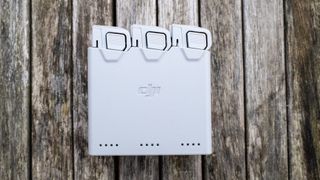
All three kits include one Intelligent Flight Battery, two sets of propellers, a screwdriver, a gimbal guard and a Type-C to Type-C PD cable. The standard kit (DJI RC-N1) also comes with three different cables to connect the controller to your smartphone.
A Fly More Bundle is also available and includes two additional Intelligent Flight Batteries, a three-battery Charging Hub, two extra sets of propellers and a Shoulder Bag, on top of the standard accessories in the standard kits. The RC-N1 Fly More Combo costs $718 | £678 while the DJI RC Fly More Combo comes in at $858 | £828.
Should you buy the DJI Mini 3?
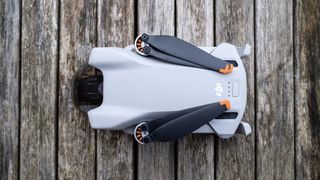
The beginner drone market is one of the fastest growing with many new models being released with a sliding scale of features and functionality. The DJI Mini 3 is the best option currently available and provides excellent image quality thanks to using the same camera as the Mini 3 Pro, albeit with slightly reduced functionality for photos and videos.
If you’re on a budget but would like excellent image quality, DJI reliability, ease of use and all in a small and lightweight package but can live without collision avoidance, the Mini 3 is for you. The cost savings compared to the Mini 3 Pro are significant and make this drone the most accessible in the DJI Mavic series line-up.
If this product isn't for you
With reduced photo and video functionality compared to the DJI Mini 3 Pro, the Mini 3 isn’t designed for professional use so more demanding users would be better off with the more advanced model of the two. Both are sub 250g drones, which are less restricted in most regions than larger and heavier models making them ideal for both beginners and more advanced plots who would like to be able to fly closer to built-up areas and people. You can pick up the DJI Mini 3 Pro for $759.
One of the problems with small and lightweight drones in the sub 250g category is that they’re not as powerful as larger and heavier models such as the DJI Mavic 3 Classic.
This drone can be flown in stronger winds and the Four Thirds camera provides the best image quality currently available in a prosumer drone. It’s more expensive, but if you need more power, additional features and/or better image quality, the Mavic 3 Classic could be the best option for you. You can pick up the DJI Mavic 3 Classic from $1599.
Join our Space Forums to keep talking space on the latest missions, night sky and more! And if you have a news tip, correction or comment, let us know at: community@space.com.
James is an award-winning freelance landscape and portrait photographer, as well as a highly experienced photography journalist working with some of the best photography magazines and websites with a worldwide audience. He’s also the author of The Digital Darkroom: The Definitive Guide to Photo Editing. www.jamesaphoto.co.uk
